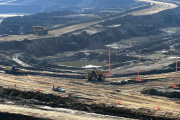While last week was the one-year anniversary of the Redford Government, it’s also an anniversary of sorts for the Pembina Institute. Two years ago, we released a road map toward responsible oilsands development that identified 19 key areas where improved environmental rules and management practices need to be strengthened. Many of the recommendations in the report, Solving the Puzzle: Environmental responsibility in oilsands development, mirror existing Government of Alberta commitments to improve on oilsands management.
Early in her mandate, Premier Redford committed to world-class natural resource management. While ensuring Alberta’s environment is protected is reason enough to strengthen the rules governing oilsands development, there is also a clear economic imperative to address the gaps in environmental protection. Alberta’s so-called “bitumen bubble,” the term coined by the premier to describe the effects of lack of pipeline access, is directly linked to customer concerns about environmental performance in the oilsands.
When the government made progress on the Lower Athabasca Regional Plan and monitoring under the leadership of Environment Minister Diana McQueen, we were cautiously optimistic that environmental management would be a newfound priority for the province — especially since the economic costs of environmental inaction are becoming clearer.
Unfortunately, that doesn’t appear to be panning out. While there has been movement on a few of our recommendations from Solving the Puzzle – most notably, the decision to conserve 1.2 million hectares of forest and a commitment to improve environmental monitoring – there is little progress to report on the 17 remaining recommendations, even though many of those solutions are long overdue.
For example, the province is five years overdue in implementing a rule that would require companies to use stored water, rather than withdrawing large volumes from the Athabasca River, during dangerously low flow levels (such as in the winter) — and there is no indication it plans to deliver on this commitment any time soon. Likewise, the province promised to implement a policy to protect wetlands in northeastern Alberta back in 2006 — but wetlands continue to be destroyed to make way for oilsands development, with no proven means to rehabilitate or replace them.
Furthermore, the province has acknowledged it needs to strengthen its climate policies to meet Alberta’s commitments to reduce greenhouse gas pollution, but has been slow to table regulations that would close the gap.
And while Premier Redford boldly told an audience in Washington D.C. that oilsands mines would halt the growth of fluid tailings by 2016 (which would represent real progress), there have been no new regulations introduced to achieve this goal — instead, thanks to weak enforcement of existing rules, toxic tailings volumes continue to increase and are expected to grow by 40 per cent by 2030.
The province ought to be able to answer critics of oilsands production with meaningful action rather than more rhetoric. The priorities of reducing climate pollution, limiting and cleaning up toxic tailings, protecting caribou habitat, enforcing existing air quality rules, conserving wetlands and preventing unsustainable water use are clear. Solving the Puzzle outlines in detail the steps to achieving progress in each of these areas and more, so the lack of progress can’t be attributed to a lack of available solutions.
We understand that change takes time, and that careful consideration and consultation is required to ensure solutions are implemented in a fair and transparent way. Many of the commitments the province has made to address existing challenges are promising, and in some instances, improvements are being worked on.
But there appears to be an overarching problem in execution, which suggests a reluctance to deviate from the status quo and through stronger policy create the space for genuine environmental leadership and innovation — despite the heightened scrutiny on oilsands management and obvious ongoing need to reduce the environmental impacts of development.
Take for example the burst of activity and debate sparked by recent media reports that Alberta was considering strengthening its approach to managing greenhouse gas pollution. While making conciliatory statements in the U.S. about the need to do more on climate change, Alberta has since been backtracking at home, hounded by political and industry opposition that takes the view that modest improvements in Alberta’s climate policy threaten our competitiveness. (Ironically, it’s because the oilsands are environmentally uncompetitive that Alberta faces such challenges to accessing markets for oilsands exports.) The Government of Alberta appears paralyzed between meeting two incompatible objectives — reassuring our international customers, who are urging us to do more to clean up the oilsands, and responding to the energy industry’s relentless lobbying at home to maintain the status quo.
The call for meaningful action isn’t just coming from outside our borders. A recent poll by Leger Marketing shows only 4 in 10 Albertans are satisfied with how the government is handling environmental issues, which indicates that taking a tougher line on environmental standards for oilsands producers would be beneficial domestically, as well as removing market barriers for our product.
While the Redford government’s progress on improving oilsands environmental performance has been disappointing to date, it’s increasingly clear that securing market access, earning the social license to operate, and ensuring long-term competitiveness will require a significant shift in how Alberta manages the oilsands. Albertans, Canadians and our customers have made this known — and with more than a dozen solutions available for the taking, the province has no excuse to delay.






